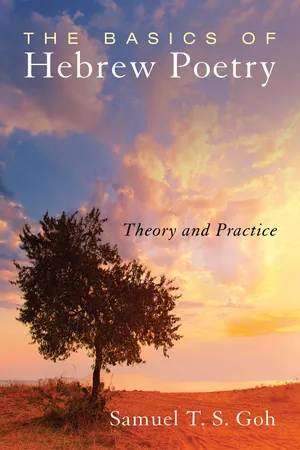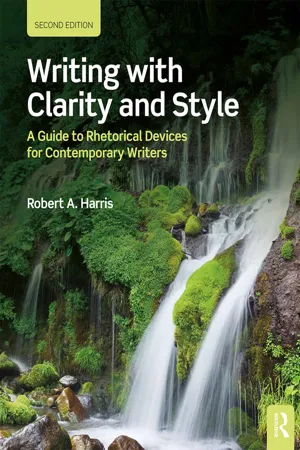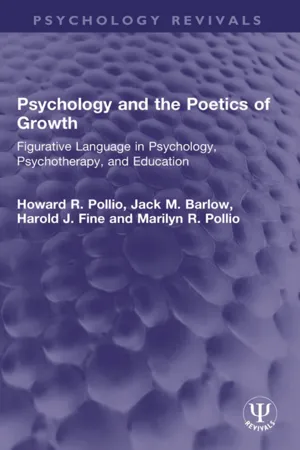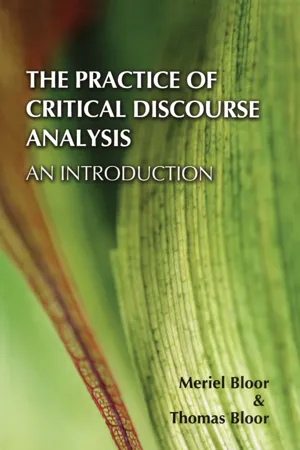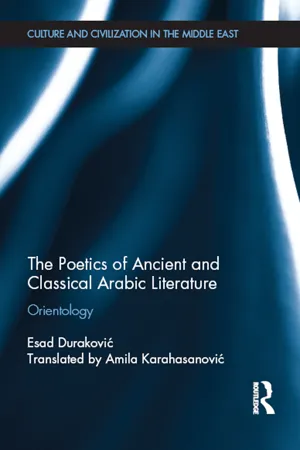Languages & Linguistics
Simile
A simile is a figure of speech that compares two unlike things using the words "like" or "as" to create a vivid image or understanding. It is used to make descriptions more engaging and to convey complex ideas in a more relatable manner. For example, "Her smile was as bright as the sun" is a simile comparing the brightness of a smile to the sun.
Written by Perlego with AI-assistance
9 Key excerpts on "Simile"
- eBook - ePub
The Basics of Hebrew Poetry
Theory and Practice
- Goh(Author)
- 2017(Publication Date)
- Cascade Books(Publisher)
411 SimileJacqueline Vaught Brogan defines Simile as follows: “a figure of speech most conservatively defined as explicit comparison using ‘like’ or ‘as.’”412 Following this definition, Simile can be identified by at least two indicators. The first one is explicit comparison ; the second one is the comparative marker that makes it explicit: “like” or “as.” So in English we have “His eyes are like saucers”; or “His eyes are as big as saucers.” Here someone’s eyes are compared to the size of saucers. In Chinese we have “strong as a cow,” in which someone’s strength is compared to that of a cow.413 Similarly, in Hebrew Simile is marked by comparison and the use of the Hebrew particle kĕ or kĕ mô (like, as), mā š al (to be like).414 Ps 1 :3 compares the righteous to a tree: “he is like a tree planted by the streams of water”; Ps 10 :9 compares the wicked to a lion: “He lurks in a hiding place as a lion in his lair.”MetaphorCompared with Simile, metaphor is more difficult to identify. One reason is that it is more concise and vaguer than Simile.415 Following Aristotle’s definition, Simile gives the reader a clue by using comparative markers such as “as” or “like.” But metaphor, being less explicit, does not offer the reader such explicit indicators. The reader is left to decide whether or not a particular expression is metaphorical.In some cases, we recognize a metaphor as we see it. We know that “barking up the wrong tree” is metaphorical even without markers such as “like” or “as.” However, in other cases, it is not so straightforward. It is one thing to say “Elina is like a rose”; it is another to say “Elina is a rose.” In the former we can be certain that we have a Simile (as indicated by the comparative marker “like”). But in the latter we are not sure if we have a metaphor, because there is a kind of rose named “Elina.”416 This case suggests that context is important for determining whether or not an expression is metaphorical and what it means. Song 2 :2 - eBook - ePub
Clarity and Coherence in Academic Writing
Using Language as a Resource
- David Nunan, Julie Choi(Authors)
- 2023(Publication Date)
- Routledge(Publisher)
For example: I have a chemistry quiz tomorrow, so I’m going to have to hit the books tonight. (hit the books = study) Come up with three words of your own and repeat the exercise.A closer look at figures of speech
In this section, we will describe and illustrate the following figures of speech: Simile, metaphor, idiom, colloquialism, cliché, and slang. We don’t want you to be too concerned about definitional differences, which can be subtle. Our main concern is that you understand the degree of acceptability of different figurative expressions in academic writing.Simile
A Simile is a device for comparing one thing with another that it does not resemble, but which the author believes captures the essence or special feature of the entity or phenomenon in question. Not all statements involving “as … as” constructions are Similes. “The Bentley is as stately as a Queen” is a Simile. “The Bentley is as stately as a Rolls Royce”, is not. “Buenos Aires is like a fading rose”, is a Simile. “Buenos Aires is like Rome”, is not.The Simile is a popular device among creative writers, particularly poets of a romantic persuasion. William Wordsworth begins his celebrated poem Daffodils with the following lines:I wandered lonely as a cloudThat floats on high o’er dales and hills.They are also used to make a point in a humorous or dramatic way, as in, A woman without a man is like a fish without a bicycle is more striking than Women have no need for men.When Similes that might have been notable when first coined are overused, they become cliches (as brave as a lion, as red as a rose, as fast as the speed of light) or colloquialisms (As angry as a cut snake [Australian English]). We have more to say about cliches and colloquialisms later, where we make the point that, when it comes to academic writing, they are best avoided.Similes in academic writing
Similes are frequently used in academic writing to make difficult or abstract concepts, comprehensible. Here are some examples from a range of disciplines. - eBook - ePub
Writing with Clarity and Style
A Guide to Rhetorical Devices for Contemporary Writers
- Robert A. Harris(Author)
- 2017(Publication Date)
- Routledge(Publisher)
8Figurative Language IAll of the rhetorical devices I have discussed are important to know and use, but the single, truly essential one to study until you gain proficiency is metaphor.—AristotleClarifying the unfamiliar by comparing it with the familiar is one of the key methods of teaching and learning. All of us try to understand something we don’t know about by comparing it to something we do know about. The devices presented in this and the following two chapters all embody this method, for they are all devices of association. An idea under discussion is illuminated or made more vivid through an imaginative comparison with something already familiar to the reader. These devices are among the most creative tools available to a writer because they frequently rely on novel comparisons and images, both of which make for a fresher, more vivid work.Simile
A Simile (SIM uh lee) compares two very different things that have at least one quality in common. While Similes are used in poetry principally for artistic effect, in formal writing they serve not only to increase interest but also to clarify an idea in an imaginative way.After long exposure to the direct sun, the leaves of the houseplant looked like pieces of overcooked bacon.In the Simile above, the subject to be compared is the leaves of the houseplant , while the image used is pieces of overcooked bacon . The word that directly expresses the comparison is like . In this instance, the writer wanted to emphasize the shriveled and brown look of the leaves, so a familiar, vivid image was chosen. Most people know what overcooked bacon looks like, so the image effectively presents a visual idea to the mind’s eye.Similes are imaginative comparisons between two fundamentally different things, not between genuinely similar ones. In fact, if the things compared are too much like each other, the comparison is not a Simile. For example, the comparison, “The office building on Main Street is like the warehouse on Perimeter Road,” is not a Simile because a building and a warehouse are too much alike. - eBook - ePub
Similes, Puns and Counterfactuals in Literary Narrative
Visible Figures
- Jennifer Riddle Harding(Author)
- 2017(Publication Date)
- Routledge(Publisher)
1People have been thinking of Simile and metaphor as twin figures for a very long time. In his classical text Rhetoric , Aristotle first laid out the form-based distinction between Simile and metaphor that would endure for centuries: “The Simile also is a metaphor; the difference is but slight. When the poet says of Achilles that he ‘Leapt on the foe as a lion,’ this is a Simile; when he says of him ‘the lion leapt,’ it is a metaphor” (1954: 173). He later adds, “those which succeed as metaphors will obviously do well also as Similes, and Similes, with the explanation omitted, will appear as metaphors” (174). This early definition establishes two ideas that this chapter will dispute: that the differences between Similes and metaphors are just inconsequential differences in linguistic structure, and that a Simile form can be converted to a metaphoric form and vice versa.Aristotle’s presentation of Simile and metaphor as twin rhetorical tropes has endured and thrived in literary studies and the popular imagination to this day. I find that my undergraduate American students can quite reliably recite the common definition of metaphor as “an implied comparison between two unlike things,” and of Simile as “an explicit comparison between two unlike things using like or as ” that most of them learned in high school or earlier. In the set of Common Core State Standards for K-12 teachers adopted in most of the U.S., students are taught the difference between Simile and metaphor, and begin developing their ability to recognize these figures in texts, at about age 9. 2 There are a number of published books that offer compilations of Similes or metaphors to general audiences, from Frank J. Wilstach’s A Dictionary of Similes (1924) and Grenville Kleiser’s Similes and their Use (1925) to the more recent collections I Never Metaphor I Didn’t Like (2008) by Mardy Grothe and Similes Dictionary - eBook - ePub
Perceiving, Acting and Knowing
Toward an Ecological Psychology
- Robert Shaw, John Bransford(Authors)
- 2017(Publication Date)
- Routledge(Publisher)
models (“imagine that these two atoms are billiard balls on a pool table … ”). Beyond these there are parables, fables, poems, plays, scientific theories, and other works of fiction. The frequency with which we use and encounter these linguistic forms makes it puzzling why there has been so little study of how we comprehend them—especially given the central role of the perception of resemblances in human cognition.The neglect of metaphor by contemporary psychology is probably due to the field’s origins in a philosophical and rhetorical tradition which had little place for such uses of language. For example, Aristotle argued that the primary function of language is the accurate description of reality, and that the closer the correspondence between words and the classes of natural things, the better this function will be fulfilled. Poetic language is “imitative,” not descriptive, and thus is distinct from the languages of rhetoric and logic, whose goals are persuasion and clarity:All such aits aie fanciful and meant to charm the hearei. Nobody uses fine language when teaching geometry (Rhetoric III; cited by Hawkes, 1972).The Aristotelian position might be summarized (and caricatured) as follows. There is a set of primitive properties by which we may classify all objects and events. Words refer to specific classes (concepts) defined in terms of those properties: hence the proper use of words may be defined in objective, physical, measurable ways. The meaningfulness of strings of words (sentences) may be evaluated as if they were selfcontained logical propositions about the properties of things. If different parts of a sentence entail incompatible properties, then the proposition is illogical and meaningless. Thus metaphoric sentences are strictly illogical. Their vividness and novelty may prove useful, in passing, to make a drab speech more eye-catching, but the meaning conveyed by the speaker is independent of them. - eBook - ePub
Psychology and the Poetics of Growth
Figurative Language in Psychology, Psychotherapy, and Education
- Howard R. Pollio, Jack M. Barlow, Harold J. Fine, Marilyn R. Pollio(Authors)
- 2023(Publication Date)
- Routledge(Publisher)
Improving the Teaching of Reading. Using numerous examples of common (frozen) figurative usage both from everyday speech and children’s classroom readers, Dechant shows the need for elementary school pupils to master metaphoric language in order to understand what they read. According to Dechant, however, children interpret figurative expressions literally and often are unaware of their mistakes in interpretation. After presenting a table containing definitions of the major types of figurative language, specific recommendations for teaching figurative reading skills are given. These include multiple-choice exercises which require the child to pick from three phrases the phrase that correctly explains a given metaphor; using Simile stems; underlining figurative expressions in poetry or prose; identifying different kinds of figures of speech; completing sentences such as “I’m hungry enough to eat a ____;” and explaining common figures of speech, illustrated by pictures of the literal meaning as contrasted with pictures of the figurative meaning. The use of such exercises is designed to familiarize the child with figurative expressions and thereby to enable him or her to deal more effectively with such expressions in the course of reading.In Reading-Language Instruction: Innovative Practices Robert B. Ruddell (1974) deals with comparisons and specifically with Simile. He feels that children should utilize mental images drawn from their own experiential background to create descriptions. He provides a simple, but interesting, activity for helping children develop comparisons in the early grades. In this regard he suggests placing sets of pictures on the board, discussing similarities and differences in the pictures and finally developing comparisons based on these observed similarities and differences. For more advanced students, Ruddell suggests that they be encouraged to explain the meaning of the term, Simile, and that the teacher make use of Simile stem exercises for this purpose.Delores Durkin (1970) , in Teaching Them to Read, includes figurative language as a means of studying variability in the meaning of a word. She feels that as reading material increases in difficulty the frequency of metaphoric language also increases, thereby making the comprehension of such usage that much more important. The study bf such language, therefore, ought to begin in the early school years by including figures of speech in the oral language used by teachers. She suggests two books, A Hog on Ice (1948) and Heavens to Betsy (1955), both by Charles Funk, that would be useful to teachers to remind them of the many idiomatic and figurative expressions found in the English language. In these books, Funk traces the historical development of frozen figurative expressions such as “spick and span,” “to chew the rag,” and so on.In summary, textbooks for teachers seem to have comparatively little to say about figurative language or how to teach it. Treatment of this topic ranges from nothing at all (Spache & Spache, 1973 ) to one sentence urging the study of such usage (Dallman, Rouch, Change, & Deboer, 1974). Dechant (1970) - Meriel Bloor, Thomas Bloor(Authors)
- 2013(Publication Date)
- Routledge(Publisher)
Simile that he had almost certainly never heard before to express a concept which was new to him. The same child, observing the letter ‘J’ on a keyboard, said, ‘That’s like grandma’s walking stick’.A metaphor is not very different from a Simile. It has been described in the literary context as making a comparison by transferring a name from one thing to another, ‘a shift, a carrying over of a word from its normal use to a new one’. The use of simple metaphors of this kind is normal in all human communication. Aristotle gave the examples ‘Achilles like a lion leapt’ (Simile) and ‘the lion leapt’ (metaphor), the latter example referring to Achilles as the lion, since ‘they are both bold’. Many of Aristotle’s examples are difficult to interpret nowadays without a close knowledge of the Greek politics and history of the period, but he also gave some striking complex examples of metaphor from contemporary speeches and comedians. One that is particularly applicable today, on women delaying the age of marriage, was My daughters are late for their own wedding.At its simplest, metaphor has been seen as a tool for representing one entity or event in the terms of some other related entity without explicitly stating a likeness, and has sometimes been presented as a poetic device which can add interest, wit or complexity to a text. Although metaphor can be used in this way, it is, more importantly, an extra resource that language offers to construct meanings. The child who compared custard to a drink was commenting on the food’s consistency and, no doubt at the age of just three years, was unfamiliar with the words liquid or viscous, but found a way to make his meaning clear.Students have sometimes been advised by teachers to write clearly and avoid metaphor. This is an impossible task since all language is imbued with metaphor and almost all new meanings involve metaphor. We use metaphor unselfconsciously because it is integral to the language: we hide our talents; we find our way through a maze of arguments; we see the point when we understand something; we fill our children’s minds with rubbish, and we clear our heads with a breath of fresh air- eBook - ePub
- Rainer Guldin(Author)
- 2015(Publication Date)
- Routledge(Publisher)
I will return to this terminological convergence of metaphor and translation in Section 9, the last section of this chapter. Metaphor is a shorter form of Simile, which has the power to make somebody’s style elegant and attractive. It can move the feelings, give special distinction to things and place them vividly before the eye. When correctly and appropriately used, metaphor will have a pleasing effect. Excessive use leads to obscurity and weariness in the audience. Metaphors should not be mean, harsh, gross or far-fetched. Above all, they must be appropriate to their subject, neither too big nor too small. Metaphors are used to produce a decorative effect or to clarify meaning. Metaphor is a borrowing that operates through the interchange of words. A noun or a verb is transferred from the place to which it belongs to another vacant place where there is no literal term available – a necessary metaphor – or because the transferred term is more impressive than that which it displaces. There are also purely ornamental metaphors. Quintilian defines four classes of metaphors, which all operate through substitution: one can substitute a living thing for another, an inanimate thing for another inanimate, an inanimate for an animate and finally an animate for an inanimate. Metaphors can produce an effect of sublimity by bringing inanimate things to life. These four kinds are subdivided into a number of species: for example, transference from rational to rational, irrational to irrational and the reverse, or from the whole to the parts and the parts to the whole. To sum up: in the wake of Aristotle’s Poetics and Rhetoric, classical rhetoric defined metaphor in spatial terms as a form of displacement and transportation. It classified metaphor as a word-focused figure of speech and described it in terms of deviation. This led to the formation of a substitution theory that ultimately relegated the role of metaphor to that of mere ornament - eBook - ePub
- Esad Durakovic(Author)
- 2015(Publication Date)
- Routledge(Publisher)
More precisely, such a poeticised relationship to the world represented a way of overcoming the sparseness of the world and its themes/contents. Everyone recognised their real world and its typicalities in the poem, identifying them as commonplaces in it, and rejoiced in the kind of shift or transposition of reality that poetry can make. Their goal was not to abandon reality or make it atypical and unrecognisable in the poem, but to poetically adorn this reality with description figures and to adapt this same reality to sound by means of a poetic form that was truly brilliant. The Simile is actually the most adequate figure for such a purpose. However refined, this poem can never leave the real world and soar up into an imaginative arch as the metaphor can. Furthermore, since both correlates of the Simile are present, and since both are from the world of reality, they promote reality, i.e. space and time, and enrich it through the relatively unexpected association of constituents. Naturally, the Simile need not take both correlates from the world of physical reality, but the introduction of the second correlate from beyond this world substantially shifts the meaning of the whole figure and would establish a different relation to the world beyond the poem. For instance, if the poet said: My beloved has arms white like my hope,/And hips that can hardly enter my consciousness,/And wrists round like a line of my poem, such a series of Similes would have an effect considerably different from the one produced by Imru’ al-Qays’ or Tarafa’s description. Both types of description (the one from the qaṣīda and mine) are equal formally, or at the structural level, and can in this respect be subsumed under the same figure of speech
Index pages curate the most relevant extracts from our library of academic textbooks. They’ve been created using an in-house natural language model (NLM), each adding context and meaning to key research topics.
Explore more topic indexes
Explore more topic indexes
1 of 6
Explore more topic indexes
1 of 4
